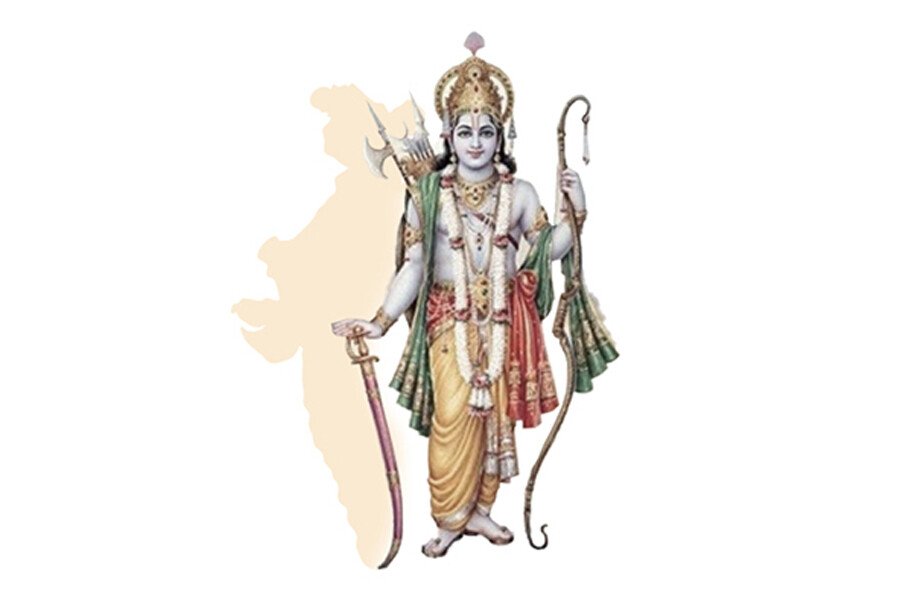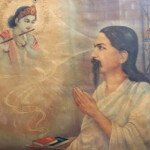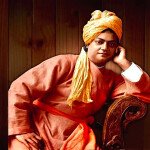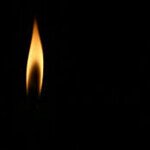The establishment of the foundation for the Ram Janmabhumi Temple at Ayodhya yesterday was a profound symbolic victory for Dharma: it was the culmination of a 490-odd years struggle for restoring Sri Ram, the seventh avatar in the line of Vishnu in Sanatan Dharma, to his rightful birthplace in the fabled city of his birth. (He was, in fact, installed for years in a tent!). Whether or not he was actually born in this exact location matters little, for Sri Ram is not just a historical being for Hindus but a Divine incarnation, and Divine Incarnations transcend time and space, birth and death of mortal bodies.
The struggle through several generations for rebuilding the temple at Ayodhya and restoring Sri Ram to his birthplace was never a religious or political issue for the Hindu — it was always a question of Dharma: for Sri Ram, for the common Hindu, is at once a complete embodiment and a shining representation of the Dharma itself: to displace Sri Ram and destroy his temple was a direct attack on the very fabric of Hindu Dharma.
Sri Ram had to be restored and the temple had to be rebuilt — this was inevitable, a historical necessity. But it took a long time — 73 years even after India’s political independence. What totally bewilders the mind is the fact that it took so long, and that it would have taken much longer had Hindutva not become as assertive as it did. If the Congress, the Islamists and the Communists had their way, all traces of Dharma would have been wiped off by now and the deracination of India would have been complete and irreversible. And to imagine that there are people who still utter such inanities as Hindutva is not Hinduism and Hinduism is not Hindutva, or that Hindutva is an aberration and Hinduism is the real thing. Let’s be very clear about this one fact: had it not been for an assertive and robust Hindutva, Hinduism, as we know it, would have been wiped out. This fact needs to sink deep into our minds and hearts.
The Prime Minister of India presiding over the bhumi-poojan of the Ram Mandir at Ayodhya was the resounding bugle call of Hindutva’s call to action and its first decisive victory. The victory, symbolic of something much wider, is deeply significant; but even more significant is the call to action: for this is only the first step. This victory, however fulfilling in the moment, must not lull us into any kind of complacency. The battle is far from over.
There are other battles to be taken up and won. Sri Ram has just been restored — but let us not forget that Sri Ram stands for Dharma, Satya and Ram Rajya. Satya is the heart of Dharma, and Dharma is the soul of Ram Rajya. Ram Rajya is neither a metaphor nor a utopian ideal: it is the natural culmination of dharmic politics and the dharmic way of life. When the life of the individual and the life of the collective become natural expressions of Dharma and Satya, when Dharma and Satya are used as the cohesive forces for nation-building, then Ram Rajya is established. Ram Rajya is not just a political theory but a growing spiritual need in the lives of men and nations. Ram Rajya is the kingdom of God on earth. To establish Ram Rajya (call it by whatever name) in India must be Hindutva’s high aim and objective. Anything short of this, and our dharma yuddha is not complete.
Let us not underestimate the challenges: A large number of educated Hindu youth, over generations, has been culturally deracinated and spiritually alienated; they have been made to believe that western values and culture are superior to their own Dharma, and that their Dharma is regressive, superstitious, and in need of systemic reform. That a large number of English-educated youth believes all this unquestioningly is not their fault — it is the education system in India, the worst case of imperialist hangover in independent India, that is to be squarely blamed. The Indian psyche has been systematically infected with the worst western ills of exploitative capitalism, aggressive competition, greed and consumerism; half-baked values of intellectualism and liberalism have been made the staple diet of the Indian intellectual. The educated Indian mind, artificially deprived of the nourishing influences of Dharma, has, over the decades, fallen into mediocrity. The youth has been taught fanciful languages but has forgotten how to speak its own idiom.
So too with the adult. The so-called modern and progressive adult Hindu has equally lost touch with his Dharma and wanders lost and confused amongst alien values and constructs. And do bear in mind that ‘alien’ has nothing to do with nationality — alien is that which is void of Dharma. The average educated Indian, thanks to the skewed education s-he has received, is still spiritually colonized and passionately believes that aping an alien culture is superior to understanding and deepening one’s own.
Wherever you look, you find the same malaise of superficiality and mediocrity in Indian intellectual and public life. Anglicized education has made us a society of well read imitators and petty-minded cynics. We have lost the depths and widenesses of Sanatan Dharma; and if that is not bad enough, we have learnt to condemn our Dharma in the language of our colonial masters. 73 years of political independence, and we are still colonized in our minds and enslaved to crass materialism in our hearts. As Indians, by and large, we have forgotten the rich integrality of our Sanatan Dharma and have become hopelessly fractured and fragmented, as individuals and as a nation.
We have lost the courage to stand for our Dharma and to fight for Satya — we have become weak and selfish over the generations, our very life force has been sapped by the forces of adharma. And adharma rages everywhere, in all directions: the monotheistic and shamelessly proselytizing Abrahamic religions are the most visible of these forces; but the hidden forces of selfishness, fear, dishonesty, falsehood and deception are the deeper and more dangerous forces of adharma. Let’s make no mistake about this: if we do not or cannot overcome the hidden forces of adharma, overcoming the visible forces will be of little value. But, on the other hand, if we vanquish the inner foes, we become towering forces of pure Dharma that no outer force or foe can shake or weaken.
All our resources and minds must combine to fight adharma, within and outside. Education is our first front. We must re-educate, revise the old narratives, keep the truths, throw out the falsehoods. We must kindle discussion and debate in the highest intellectual traditions of our Dharma. We must rebuild the minds and hearts of young India. The new national education policy, released just a few days ago, is the first step in the right direction. But we need to go farther, much farther.
We have to confront multiple falsehoods and deliberate attacks on our Dharma. We need to rebuild narratives, reconnect our heritage and our destiny, our past and our future, which have been ruptured, first by the Islamic invasions and then by the British Raj. We have to boldly reclaim the truths of our Dharma, without apology or hesitation. Dharma is our birthright and we must learn, once again, to demand our birthright.
In one of the inspired modern day mahavakyas of the Indologist Koenraad Elst, What Hindus… will have to learn, is that the essence of Hindu Dharma is not ‘tolerance’ or ‘equal respect for all religions’ but Satya, Truth. It is to this Truth that the Hindu raises temples and installs deities; the outer names and forms are mere contexts.
For those interested in this subject: please read this and this











